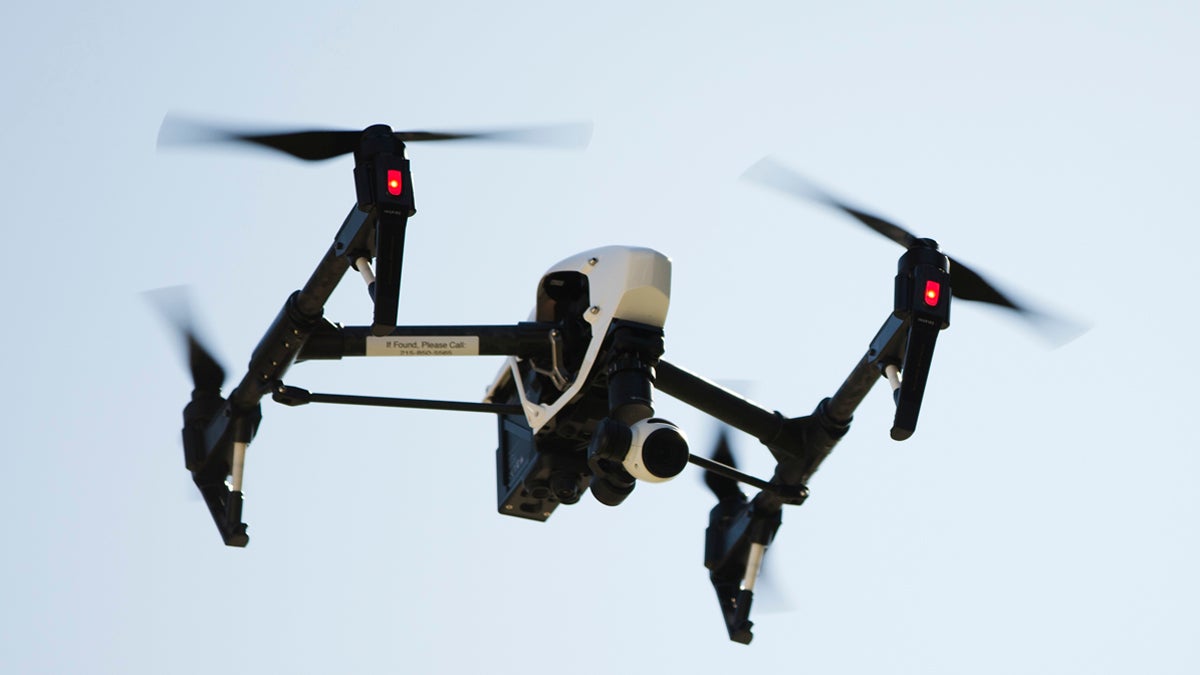Why the debate over drones all goes back to avian suicide

A drone captures videos and still images of an apartment building in Philadelphia. (AP Photo/Matt Rourke
The Federal Aviation Administration is due to release rules for drone operation over populated areas in a couple weeks. Interest is high in many sectors, including local government.
This upcoming set of FAA guidelines will be the second released by the federal government. The first was published last summer, but left many unanswered questions. It also came about a decade after smaller drones became available to civilians for an attainable price that’s since steadily dropped. In the meantime, some municipalities — including at least a dozen in Pennsylvania — enacted their own rules in response to constituent concerns about the new, unfamiliar technology buzzing right over their own backyards (in some cases, literally).
That might explain why so many local officials packed the panel about drones at the National League of Cities conference this month. The standing-room-only crowd was rare for the summit, especially given that it was a Saturday morning.
The panel was moderated by Gregory McNeal, a Pepperdine University law professor who created a mobile app for drone operators and formerly taught at Dickinson Law school.
Speakers included FAA Chief Counsel Reggie Govan, California-based municipal attorney Nicole Witt, San Francisco International Airport Director Ivar Satero and James Grimsley, an aerospace engineer who heads a drone-focused R&D firm and is associate vice president of research at the University of Oklahoma.
The 90-minute panel flew by. In no particular order, the most fascinating takeaways:
• It all goes back to avian suicide
The year was 1942. Thomas Lee Causby had been raising chickens on his farm outside Greensboro, North Carolina, when an airport was built nearby. Planes soon were flying as low as 86 feet above Causby’s property. The noise and vibrations so disturbed his chickens that most stopped laying eggs and many flung themselves into the side of their coop, with fatal consequences. Causby filed a lawsuit, ultimately prevailing in a 1946 decision by the U.S. Supreme Court. The court concluded that the flight activity was infringing on Causby’s rights to space above the ground he owned (generally referred to as “air rights”). After that, the government bought private property surrounding the airport or military bases (or took it by eminent domain) to avoid infringing on these air rights during takeoffs and landings.
• Municipal involvement in aviation is rooted in runways
When it comes to drones, the FAA’s view is that cities and counties have no regulatory role. Those governments have been involved and consulted in airport development because the Constitution grants them jurisdiction over land use, and manned aircraft requires a lot of ground to get up to speed for liftoff (i.e., a runway). Drones don’t require the same sort of windup (none, actually) to get airborne.
• Gray skies ahead
The FAA has jurisdiction over navigable airspace — which, historically, has been defined as starting 500 feet above populated areas. Zones lower than that have generally been considered a legal gray area in many cases. Unmanned aerial systems, however, fly much lower than that, and that, in the FAA’s view, has redefined navigable airspace. But during the years-long federal rule-making process, some municipalities pointed to the historic ambiguity of activity under 500 feet overhead as justification, in part, for moving ahead of the feds on drone regulation.
• Alternate routes for local drones laws might work
The general consensus of the panel was that there are many unknowns, but that cities might be fine to regulate drone operation without conflicting with federal law if they do it through zoning, noise ordinances, curfews, permits or registration.
• California as a case study
Govan shared some details about state laws regarding drones passed recently in California. One is intended as a paparazzi protection initiative, prohibiting drone flying onto private property where one would otherwise have to trespass to access it. Two others deal with first responders. The first prohibits drones from interfering with first responders dealing with an emergency; the second absolves first responders of damage done to drones during an emergency.
• Could drones force local governments to embrace digital infrastructure?
McNeal says the Department of Interior, as well as 130 airports and a number of other agencies, already are plugged into his AirMap mobile app, which uses their info feeds and GPS data to help drone operators fly safely.
“You could imagine a system where every county or city is given a tool for communicating this way,” McNeal said after the panel. “Some system that harmonizes it — allows drones to operate — but also makes sure that the granular information about where drones should avoid is fed right into a system that everybody can understand.”
He likened the embrace of GPS and other data-sharing for drone operation to how cities are utilizing it to deal with parking and traffic engineering.
“It would almost be the infrastructure of the future.”
Editor’s note: This post has been updated to correct McNeal’s name.
WHYY is your source for fact-based, in-depth journalism and information. As a nonprofit organization, we rely on financial support from readers like you. Please give today.



